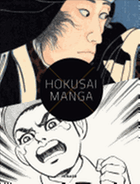
Serving much the same function that manga and comic books do today, ukiyo-e (meaning "the floating, transient world"--the art of Japanese woodblock prints and paintings) arose in 17th-century Japan to satisfy public appetites for escapism from the rigidity of everyday life. Ukiyo-e offered safe ways to explore fears and experience the sensual pleasures of taboo subjects; they also served as advertisements for kabuki productions and as ringing endorsements for travel to the Edo capital. Hokusai X Manga developed from a permanent exhibit of ukiyo-e at Germany's Museum für Kunst und Gewerbe Hamburg. It captures the many facets of this art form: the haunting religious imagery in yōkai ("hybrid spirits"); the quiet spirituality of geometrically layered, Prussian-blue landscapes; erotica, forbidden love and heroic battles.
The anthology does a wonderful job of exploring the art form's origins and providing cultural context behind its mass appeal. The editors also analyze the visual techniques used in creating woodblock art, particularly in the development of the first comics, kibyōshi, which were cheaply assembled booklets of sequential pictures. Kibyōshi would become the precursors to the modern manga movement and influence anime greats such as Hayao Miyazaki (Spirited Away) and Shigeru Mizuki (Kitaro). Though Hokusai X Manga fails to address the more widespread influence of these 17th-century Japanese artists on the West, this collection and its colorful commentary should serve as a valuable reference tool for manga enthusiasts and art collectors, with a good sampling of the best ukiyo-e prints. --Nancy Powell, freelance writer and technical consultant

